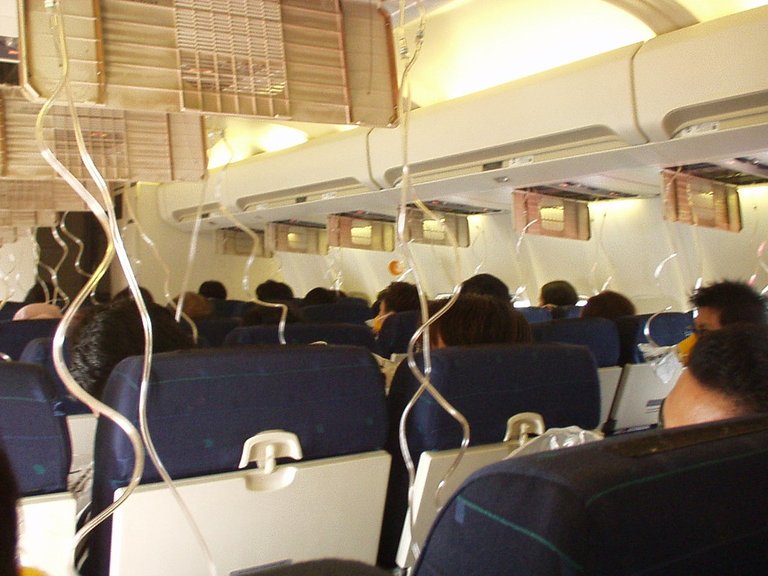How Staphylococcus Aureus Poisoning Almost Killed 300 Plane Passenger
When embarking on a lengthy journey, opting for a flight is not only more convenient but also faster, and it usually comes with the promise of refreshments, no matter how modest. Personally, I always look forward to the in-flight refreshment as part of the overall travel experience. However, a disconcerting incident in 1975 made me reconsider the safety of consuming food served on planes.
In 1975, a Japan airline carried 300 passengers from Tokyo to Paris, and from the look of things they were going for vacation as they were sales people for Coca-Cola, along with their family members who had won a vacation to Paris. Including stops, the trip was meant to take 20 hours and that was a long time not to get a refreshment from the plane crew.

They were going to have a first stop over at Anchorage (U.S.A) and this went smoothly. Earlier sandwiches had been handed to the passengers, an it was time for another meal since it was getting breakfast time. It was at this time that Ham omelettes were handed over to passengers. The omelettes were reheated and served on their way to Kastrup Airport in Copenhagen and then something happened after they ate the meal. Almost half of the passengers were sick.
They were nauseated, vomiting, suffering from cramps, and having diarrhea. They were seriously sick and there was a high demand for the lavatory that the pilots had to make a quick landing at Kastrup Airport in Copenhagen. They were all hospitalized due to the severity of their condition and test needed to be done to ascertain what was wrong.
Language barriers initially complicated the investigation, but translators were quickly enlisted, and tests were conducted on various samples, including urine, vomit, feces, spit, and, crucially, the omelettes. Although the authorities suspected the omelette but they wanted to be sure before making any statement. It was funny that people who sat at the back of the plane were fine while those in the middle and those in first class suffered from this food poisoning. When the tests were done, there was a common pathogen, and that was Staphylococcus aureus which was also present in the omelette.

It is expected that the airline staffs should have followed strict guidelines, so where did the food get this toxin producing bacteria. Actually we would have expected them to follow strict guidelines but did they actually follow strict guidelines? After the food was made, the food was kept on the table at room temperature for about 6 hours, and then stored in a refrigerator at 10 degree Celsius or instead of 4 degree Celsius. After which they were stored in the planes oven without refrigerating for hours again before it was reheated and served.
This was enough time for bacteria to grow and release toxins since the conditions were favorable. On further investigation, it was noticed that the staph came from one of the chef that prepared the meal. The Chef had lesions on his hands, and decided to cover them while cooking instead of reporting to his superior. After examining the chef's hand, it was discovered that the lesions had Staphylococcus aureus, and that was were the injury came from. It took only 100 staphylococci to get people sick, and this people would surely have had loads of staphylococci that had accumulated toxins and spores.
While the chef's negligence played a significant role, the shortcomings in the storage process were equally troubling. The revelation that the staph produced heat-resistant spores raised concerns about the efficacy of reheating in eliminating toxins. In essence, the cook, the management overseeing food safety, and the flawed storage procedures collectively contributed to the unfortunate conditions experienced by passengers on a holiday journey with their families.
The pilots didn't eat the Omelettes and that was why they were able to land the plane, to safe the passengers. If they had eaten the omelettes, they might not be able to land the plane properly and it might have been catastrophic. When I say catastrophic, I didn't mean there was no fatality because there was one. The catering manager for the airline Kenji Juwabara died 2 days after, not by the poisoning but from the shame of the incident, as he committed suicide.
Read More
- https://www.nytimes.com/1975/02/07/archives/illness-on-japanese-jet-is-traced-to-alaskan-cook.html
- https://www.nytimes.com/1975/02/11/archives/catering-official-kills-himself-food-poisoned-144-on-jetliner.html
- https://www.thelancet.com/journals/lancet/article/PIIS0140-6736
- https://flightsafety.org/ccs/ccs_nov-dec89.pdf
- https://www.cdc.gov/foodsafety/diseases/staphylococcal.html
- https://www.msdmanuals.com/home/digestive-disorders/gastroenteritis/staphylococcal-food-poisoning
- https://www.ncbi.nlm.nih.gov/pmc/articles/PMC3153270/
Interesting story thank you. Sitting in the back of the plane was the best place to be to avoid contagion ✈️ their only small problem was when people were clamoring to pushing to use that lavatory. That's still far better than the fate of the passengers toward the front who ate the omelet. Did anyone else read to the end about the chef's disgusting hands full of lesions.
Thanks for your contribution to the STEMsocial community. Feel free to join us on discord to get to know the rest of us!
Please consider delegating to the @stemsocial account (85% of the curation rewards are returned).
Thanks for including @stemsocial as a beneficiary, which gives you stronger support.
Congratulations @eni-ola! You have completed the following achievement on the Hive blockchain And have been rewarded with New badge(s)
Your next target is to reach 85000 upvotes.
You can view your badges on your board and compare yourself to others in the Ranking
If you no longer want to receive notifications, reply to this comment with the word
STOPCheck out our last posts:
I wonder why people just choose to commit suicide over something they couldn't have been able to control.